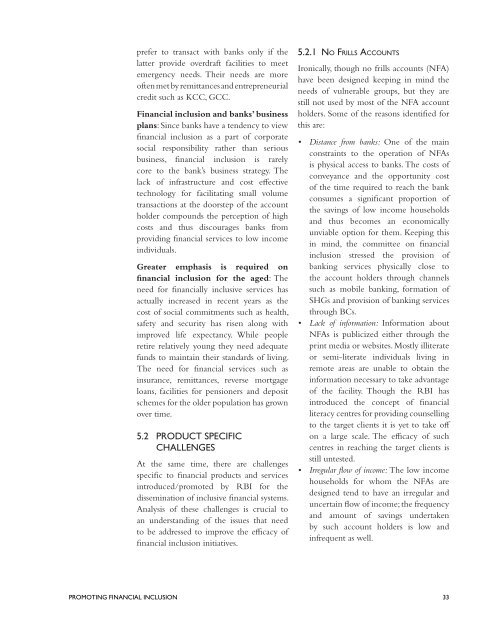Promoting Financial Inclusion - United Nations Development ...
Promoting Financial Inclusion - United Nations Development ...
Promoting Financial Inclusion - United Nations Development ...
Create successful ePaper yourself
Turn your PDF publications into a flip-book with our unique Google optimized e-Paper software.
prefer to transact with banks only if the<br />
latter provide overdraft facilities to meet<br />
emergency needs. Their needs are more<br />
often met by remittances and entrepreneurial<br />
credit such as KCC, GCC.<br />
<strong>Financial</strong> inclusion and banks’ business<br />
plans: Since banks have a tendency to view<br />
financial inclusion as a part of corporate<br />
social responsibility rather than serious<br />
business, financial inclusion is rarely<br />
core to the bank’s business strategy. The<br />
lack of infrastructure and cost effective<br />
technology for facilitating small volume<br />
transactions at the doorstep of the account<br />
holder compounds the perception of high<br />
costs and thus discourages banks from<br />
providing financial services to low income<br />
individuals.<br />
Greater emphasis is required on<br />
financial inclusion for the aged: The<br />
need for financially inclusive services has<br />
actually increased in recent years as the<br />
cost of social commitments such as health,<br />
safety and security has risen along with<br />
improved life expectancy. While people<br />
retire relatively young they need adequate<br />
funds to maintain their standards of living.<br />
The need for financial services such as<br />
insurance, remittances, reverse mortgage<br />
loans, facilities for pensioners and deposit<br />
schemes for the older population has grown<br />
over time.<br />
5.2 PRODUCT SPECIFIC<br />
CHALLENGES<br />
At the same time, there are challenges<br />
specific to financial products and services<br />
introduced/promoted by RBI for the<br />
dissemination of inclusive financial systems.<br />
Analysis of these challenges is crucial to<br />
an understanding of the issues that need<br />
to be addressed to improve the efficacy of<br />
financial inclusion initiatives.<br />
5.2.1 NO FRILLS ACCOUNTS<br />
Ironically, though no frills accounts (NFA)<br />
have been designed keeping in mind the<br />
needs of vulnerable groups, but they are<br />
still not used by most of the NFA account<br />
holders. Some of the reasons identified for<br />
this are:<br />
• Distance from banks: One of the main<br />
constraints to the operation of NFAs<br />
is physical access to banks. The costs of<br />
conveyance and the opportunity cost<br />
of the time required to reach the bank<br />
consumes a significant proportion of<br />
the savings of low income households<br />
and thus becomes an economically<br />
unviable option for them. Keeping this<br />
in mind, the committee on financial<br />
inclusion stressed the provision of<br />
banking services physically close to<br />
the account holders through channels<br />
such as mobile banking, formation of<br />
SHGs and provision of banking services<br />
through BCs.<br />
• Lack of information: Information about<br />
NFAs is publicized either through the<br />
print media or websites. Mostly illiterate<br />
or semi-literate individuals living in<br />
remote areas are unable to obtain the<br />
information necessary to take advantage<br />
of the facility. Though the RBI has<br />
introduced the concept of financial<br />
literacy centres for providing counselling<br />
to the target clients it is yet to take off<br />
on a large scale. The efficacy of such<br />
centres in reaching the target clients is<br />
still untested.<br />
• Irregular fl ow of income: The low income<br />
households for whom the NFAs are<br />
designed tend to have an irregular and<br />
uncertain flow of income; the frequency<br />
and amount of savings undertaken<br />
by such account holders is low and<br />
infrequent as well.<br />
PROMOTING FINANCIAL INCLUSION 33

















